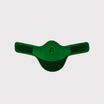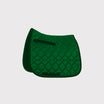Diabetes mellitus, as diabetes is officially known, is a disease that occurs regularly in cats. There are different forms of diabetes mellitus. Cats commonly suffer from Type II. In other words, "life-style" diabetes. This diabetes is often caused by a combination of multiple causes, including obesity. There are four types of diabetes (type I, type II, type III and gestational diabetes).
How does diabetes develop in cats?
Diabetes mellitus is defined as high blood sugar levels. In type II diabetes, this is due to reduced insulin secretion by the pancreas and insulin resistance. Obesity and physical inactivity lead to insulin resistance. The organs become less sensitive to insulin. Normally there is a balance, but when there is too little exercise relative to eating too much, that balance is upset. Indeed, reserve build-ups are constant and collapses are rare. As a result, the organs become less sensitive to the hormone insulin over time.
To compensate, the pancreas produces more and more insulin and becomes exhausted. Over time, the pancreas will stop producing insulin. This leads to a lack of insulin and high blood sugar levels. When there is no more insulin, no more sugar is absorbed from the blood.
How does insulin work?
Normally, when your cat eats, it is absorbing nutrients. All of the nutrients a cat eats are converted into "good" sugars (glucose) in the liver. Every animal depends on this sugar to survive. Once these good sugars enter your cat's blood, the pancreas begins to produce insulin and blood insulin levels rise. This higher level of insulin ensures that the glucose is taken up by all types of cells, such as the muscles and brain. This is very important as these cells depend on the glucose to do their job properly.
What causes diabetes in cats?
In addition to obesity and lack of exercise, there are other causes of diabetes mellitus. Cushing's syndrome (hypercortisolism) is one of them, almost all cats with Cushing's syndrome develop diabetes. Fortunately, Cushing's syndrome is rare in cats.
Another cause of diabetes mellitus is glucocorticoid therapy. An important side effect of these drugs is that they stimulate the liver to produce glucose. This glucose enters the blood unintentionally. This eventually leads to high blood sugar levels.
Diabetes mellitus is slightly more common in male cats than in female cats.
How do I recognize diabetes in my cat?
Traditionally, diabetes mellitus can be recognized by drinking and urinating a lot. Also, your cat eats a lot. Sometimes diabetes mellitus is complicated by “ketoacidosis”. Because your cat's organs are no longer absorbing glucose, they can no longer use the glucose to do their jobs. These organs then switch to other nutrients, such as fats. When fats are used by organs for energy, ketones are released. These ketones (or ketone bodies) return from the organs to the blood. Normally these are filtered by the liver or kidneys. In diabetes mellitus, so many ketones are released that the liver and kidneys can no longer filter properly. These ketones then build up in the blood and ketoacidosis develops. Cats with ketoacidosis stop eating, vomit, have diarrhea, are lethargic, and show weakness.
Cataracts can occur in older animals, which can be recognized by a blue/white haze in the eye. Cataracts in older animals are not always the result of diabetes!
How is diabetes diagnosed?
Your vet will first examine your cat's urine. Drinking and urinating a lot can also have other causes. Sometimes glucose can be detected in the urine and then the diagnosis is made. In most cases, the urinalysis is not enough and your vet will need to do another blood test.
How is diabetes treated in cats?
Diabetes mellitus due to glucocorticoid therapy is easily treatable. Discontinuation of therapy leads to recovery from diabetes mellitus. Unfortunately, it is not always possible to stop this therapy. Sometimes this therapy is necessary in the treatment of another disease. Note: Never stop this therapy abruptly! This is life-threatening, this therapy must be discontinued!
The other form of diabetes mellitus is treated with insulin. This treatment demands a lot from you as the owner. It is certainly very difficult at first to find the right dose of insulin. There is a risk of insulin overdose, which can cause blood sugar levels to drop dangerously low. In addition, there is a risk that the insulin dosage is too low, so that the symptoms do not subside. Sometimes it takes a long time to find the right dose while you, the owner, are still suffering from the side effects of diabetes mellitus. A good therapy can (almost) always be found and it is often a question of persistence and searching until the right dose is found.
In addition to insulin treatment, it is important that your cat lose weight and exercise more. In addition, there are studies that show that a low-carb, high-protein diet increases the likelihood that diabetes mellitus will go away.
In cats, too, diabetes mellitus can be inhibited in some cases. Your cat can even heal! Research shows that this is more common when therapy is started early. So don't wait too long before going to the vet.
This text was translated by a translation machine
 Horse Pharmacy
Horse Pharmacy Rugs
Rugs Care
Care Saddle and Attachments
Saddle and Attachments Leg Protection
Leg Protection Bridles
Bridles Feed
Feed Fly Masks
Fly Masks Saddle Pads
Saddle Pads Headcollars and Ropes
Headcollars and Ropes Bits
Bits Other Disciplines
Other Disciplines Reins and Auxiliary Reins
Reins and Auxiliary Reins Clipping
Clipping Western
Western Eventing
Eventing Foals
Foals Reflection
Reflection Therapy Products
Therapy Products Boots and Shoes
Boots and Shoes Breeches and Belts
Breeches and Belts Tops
Tops Safety
Safety Competition
Competition Heated Clothing
Heated Clothing Gloves
Gloves Socks
Socks Spurs and Attachments
Spurs and Attachments Technology
Technology Whips
Whips Gifts
Gifts Casual Wear
Casual Wear Underwear
Underwear Rider Pharmacy
Rider Pharmacy Bags
Bags Books
Books Laundry supplies
Laundry supplies Jewelry
Jewelry Feed and Waterbowls
Feed and Waterbowls Equipment
Equipment Tack Room
Tack Room Pest Control
Pest Control Arena
Arena Horse Toys
Horse Toys Wheelbarrows
Wheelbarrows Yard
Yard Surveillance
Surveillance Disinfect
Disinfect Washing Area
Washing Area Lighting
Lighting Horse Pasture
Horse Pasture Current Conductors
Current Conductors Pole
Pole Insulators
Insulators Energisers
Energisers Gate Handles
Gate Handles Batteries and Accumulator
Batteries and Accumulator Nets
Nets Grounding
Grounding Tools
Tools Fencing Security
Fencing Security Wolf Defense
Wolf Defense Fencing Sets
Fencing Sets Fence locks
Fence locks Dogs
Dogs Cats
Cats Rodents
Rodents Dogs Pharmacy
Dogs Pharmacy Cats Pharmacy
Cats Pharmacy Rodents Pharmacy
Rodents Pharmacy Cattle Pharmacy
Cattle Pharmacy Poultry Pharmacy
Poultry Pharmacy Veterinary Supplies
Veterinary Supplies Cattle
Cattle Sheep and Goats
Sheep and Goats Poultry
Poultry Heat Lamps
Heat Lamps Calves
Calves Marking
Marking Halters
Halters